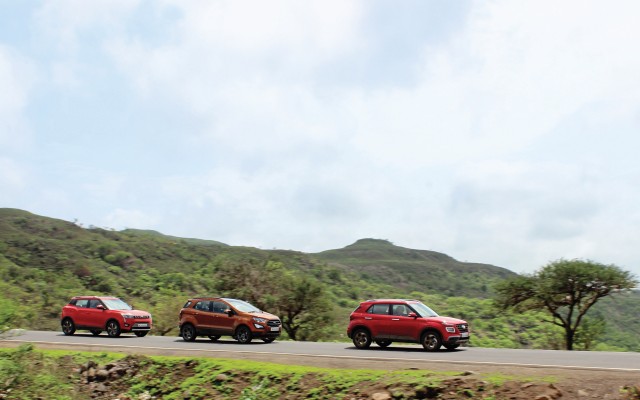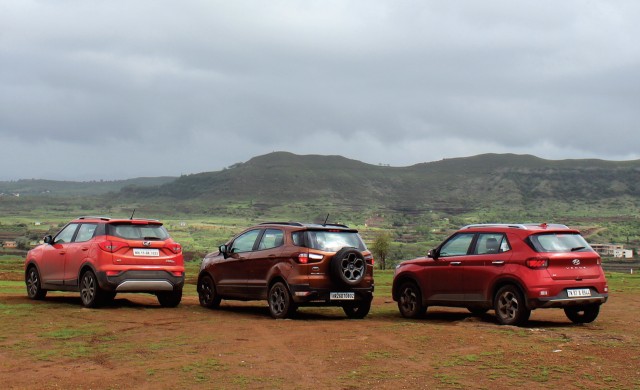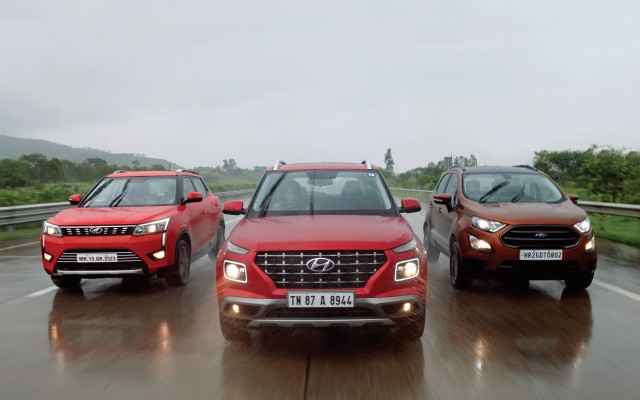Drive

The Venue, with its 220 Nm and six-speed gearbox can be effortlessly driven in early gears without bothering about the clutch pedal as the hefty idle torque map does its job more than well enough. The accelerator pedal felt far too immediate in response to my liking, but my colleagues felt otherwise. Even so, the refinement is fantastic. The 1.4 CRDi turbo-diesel does duty in the heavier Verna and Creta and feels peppy in the Venue. That shows in its acceleration figures, getting up to 100 km/h in 14.4 seconds, after hitting 60 in just 5.6 seconds, with the power delivery tapering off slightly as the revs rise. The steering feel is excellent and the Venue feels agile and nimble. The ride quality is very good and it handles rough roads and changes of direction well. However, some ungainly bumps led to a thud from the rear axle, mostly down to soft rebound damping. Either way, next to nothing manages to upset it. Under braking at speed, however, the Venue gets a little unsettled, so coming to a stop is best done gradually. It prefers relaxed driving and feels good doing what it does best: being a well-equipped city crossover up for an occasional highway trip. It’s also very efficient, clocking 15 km/litre in the city and 20 on the highway. That’s an overall 16.25 and range of around 730 km considering the 45-litre tank.
The Ford EcoSport is a dynamically-gifted car, as is every Ford, and, thus, is fun to drive in all conditions. Its high ground clearance is a boon for bad or flooded roads and it feels extremely capable all round. Its proportions are rather curious at first, but once accustomed, it’s quite the compact car. The turning circle radius, at 5.3 metres, is pretty tight, too. The engine may be an old-school SOHC eight-valver, but it has the grunt to pull off some good acceleration. Naught to 100 km/h was dismissed in 12.7 seconds and it can hold highway speeds all day long if needed. The suspension and steering feel are calibrated to make the driver feel good with the respective responses and it doesn’t disappoint. Economy-wise, with figures of 14 km/l in the city and 20 on the highway, that’s an overall 15.5 km/l. With a 52-litre tank, that’s about 800 km.
The XUV300’s best-in-class figures are evident on the go. The engine only revs to about 3,700 rpm but that’s more than is needed. The 300 Nm of peak torque at 1,500 rpm means there is more than enough grunt and it can be driven at 1,000 rpm even in higher gears, while getting around the city is easy too. The robust build and commendable handling dynamics make it an incredible proposition, and not just for a Mahindra. It feels planted, sorted, and stable at all times and has a tight 5.3-metre turning radius, too. It isn’t the quickest off the mark, taking 6.3 seconds to 60 km/h and 14.3 seconds to 100, but it has loads of grunt and feels effortless. That said, on the move, the high bonnet, thick A-pillar and the wing-mirror positioning create somewhat of a blind-spot which, globally, may not be a problem, but when traffic and pedestrians approach from a dozen directions, it becomes something to keep in mind. That apart, there were some squeaks from the cabin, probably due to contact between panels and upholstery, which is something Mahindra should focus on ironing out. Overall, it’s a commendable car and one to consider in this segment. It’s heavier, too, and it shows in its economy, at 13.5 km/l city and 20 on the highway. That’s just over 15 overall and the tank capacity of 42 litres means a range of around 630 km.
Price and Verdict
On the value front, they all have their plus points and some minor minus points, but it’s very close on the practicality and equipment front. The XUV300 is the most spacious and best-equipped car but comes at a price: Rs 12.14 lakh (ex-showroom) to be precise for the W8(O). The diesel range begins from Rs 8.69 lakh, though, and a diesel auto is also available, so finding one that suits your needs shouldn’t be a problem.
The EcoSport has been around for a while. This Titanium S costs Rs 11.35 lakh. A “Thunder” package is also on offer with those 17-inch wheels and a lot of additional kit. The EcoSport range starts from Rs 8.31 lakh.
The Venue offers the most refinement and excellent value. At Rs 10.84 lakh for this SX(O) variant, it’s not too steep. The range starts at just Rs 7.75 lakh for the near bare-bones E trim.
I’ve been asked to pick a clear winner but, clearly, there isn’t one. They all have their virtues and idiosyncrasies. Some of my colleagues would pick the Venue. If I had to put down my own money, though, I’d cough up the extra and have the XUV.

Also Read: Ford EcoSport First Drive Review
Also Read: Mahindra XUV300 First Drive Review





















Leave a Reply